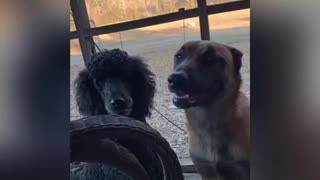Premium Only Content

Do you like dogs too?
The dog (Latin: Canis familiaris) is a domestic animal belonging to the wolf family. Distributed in all countries. Wild ancestor wolf. It was domesticated in the Mesolithic period (15-10 thousand years BC). The olfactory, auditory, and visual organs, as well as the brain, are well developed. There are 42 teeth in the years, and the pile tooth is extremely strong. The female reaches sexual maturity at 7-8 months, the male at 10-12 months, the male is called I. arlon, and the females (females) hatch twice a year. The gestation period is 58-65 days. Born from 1-2 to 12-18. I.'s newborn is called a dog. Puppies are born blind, deaf, and toothless. After 10-14 days the eyes open, after 5-8 days the ears begin to hear, and the baby teeth erupt in 20-30 days. He did not eat his mother for 1-1.5 months, after which he began to take care of other foods. I. live 12-15 years, some breeds up to 17 years. They range in height from 16-18 cm to 100 cm and weigh from 600 g to 90 kg. Home I.s can also go wild. The only species of dingo that lives in the wild is the dingo, which is mainly distributed in Australia (wild I. is found in the Kuril Islands). More than 400 species of I. are known in the world. I. is divided into 3 main groups: service I.s, hunter I.s, decorative I.s.
Service I.s perform security and special services (military, search, guard, transport). They are kept in rich, empty or separate cages (rooms). They have many breeds. Mas, ovcharkalar, doberman-pincher, boxer, erdelyer, black terrier, dog, senbernar, nyufaunlend. These types of I.s are hardy, hardy, and quick to learn human commands and exercises. They are able to perform unique tasks on the battlefields, such as searching for and removing wounded, communications, mines, and drugs. Eastern European hunting is widespread in Uzbekistan. The closest auxiliary I.s to man are the shepherd I.s. In addition to dogs, Caucasian, Mongol, and Scottish shepherds protect their herds from wolves and perform "herding" functions to prevent the herd from becoming extinct. In the far north, I.s are added to the sledge and used as a means of transport (10-12 I. added sleds can carry 400-500 kg of weight in a day for a distance of 80-100 km).
There are more than 100 breeds belonging to the group of hunter I.s, salt, laycha, setter, poynter, layka, iskovuch, etc. These help hunters to find wild animals and birds. Sports competitions are also held with hunter I.s. Among the decorative I. kept in the house are long-haired barracks I., curly wool barracks I., balloons, small terriers, poodles, spitzes, Beijing and Japanese dogs, mopeds. They are of almost no economic importance and are fertilized and fed only by I. laborers.
-
 0:50
0:50
misfitsandrescues
3 years agoDogs can act like gentlemen too
23 -
 14:39
14:39
Talk Nerdy Sports - The Ultimate Sports Betting Podcast
1 hour ago3/30/25 - 🎙 Sunday Funday Fire: 10 Sharp Bets, 5 Parlays & 2 Locks That Hit Different
8.52K -
 2:01:52
2:01:52
Game On!
21 hours ago $15.95 earnedMarch Madness Final 4 Will Be Set TODAY!
65.5K4 -
 3:41:49
3:41:49
LumpyPotatoX2
5 hours agoHunt Shadows Family Sunday - #RumbleGaming
37.4K4 -
 5:04
5:04
Film Threat
1 day agoA WORKING MAN | Film Threat Reviews
38.5K4 -
 22:08
22:08
Misha Petrov
1 day agoMain Character Syndrome Is Spreading
43.6K67 -
 LIVE
LIVE
NeoX5
3 hours agoAssassin's Creed: Shadows - Wheelin and Dealin #Factor75partner | Part 6 | Rumble Gaming
93 watching -
 LIVE
LIVE
Chi-Town Gamers Livestreams
3 hours ago $0.63 earnedBaldur's Gate 3 W/ CTG & XayRico Ep. 4 *FOR REAL THIS TIME* | 9 Hour Stream...LFG!
152 watching -
 LIVE
LIVE
DarknessGames
17 hours agoIT'S BACK! - Dark Souls II (Part 7)
79 watching -
 28:30
28:30
CatfishedOnline
1 day agoWoman Wants to Leave BF for Lover or Romance Scam?
47.6K20